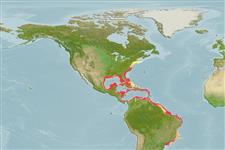>
Eupercaria/misc (Various families in series Eupercaria) >
Lutjanidae (Snappers) > Lutjaninae
Etymology: Ocyurus: Greek, okys = quick + Greek, oura = tail.
More on author: Bloch.
Environment: milieu / climate zone / depth range / distribution range
ນິເວດວິທະຍາ
ສັດທະເລ ກ່ຽວກັນຫີນ; ລະດັບຄວາມເລິກ 0 - 180 m (Ref. 10795), usually 10 - 70 m (Ref. 55229). Subtropical; 42°N - 26°S, 98°W - 31°W (Ref. 55229)
Western Atlantic: extending northward to Massachusetts, USA and Bermuda and southward to southeastern Brazil, in Gulf of Mexico and Antilles (Anderson, pers. comm.). Most common in the Bahamas, off south Florida and throughout the Caribbean. Lutjanus ambiguus (Poey, 1860), an intergeneric hybrid with Lutjanus synagris (Linnaeus) as demonstrated by Loftus (1992: Ref. 33006), followed by McEachran &. Fechhelm (2005: Ref. 78464).
Length at first maturity / ຂະໜາດ / ນ້ຳໜັກ / Age
Maturity: Lm 23.8, range 14 - 31 cm
Max length : 86.3 cm TL ຕົວຜູ້/ບໍ່ມີເພດ; (Ref. 9626); common length : 40.0 cm TL ຕົວຜູ້/ບໍ່ມີເພດ; (Ref. 55); ນ້ຳໜັກສູງສຸດທີ່ເຄຍຈັດພີມມາ: 4.1 kg (Ref. 40637); ອາຍຸສູງສຸດທີ່ເຄຍລາຍງານມາ: 14 ປີ (Ref. 3090)
ຄີ (ໜາມ)ແຂງຢູ່ຫຼັງປາ (ທັງໝົດ) : 10; ຄີຫຼັງຂອງປາ (ຄີອ່ອນ) (ທັງໝົດ) : 12 - 14; ຄີ(ໜາມ) ແຂງຢູ່ຄີກົ້ນປາ
ກຸ່ມປາກະດູກແຂງ
ຄວາມຖີ່ຂອງກຸ່ມຖ່າຍທອດພັນ
ປາທີ່ມີການເຄື່ອນຍ້າຍຈາກທະເລໄປຫານ້ຳຈືດ ແລະນ້ຳຈືດຫາທະເລ
ປາທີ່ມີການເຄື່ອນຍ້າຍຈາກທະເລແລະໄປໄຂ່ຢູ່ນ້ຳຈືດ
ຄີກົ້ນຂອງປາ
ສັດທີ່ມີກະດູກສັນຫັຼງ
ການຖ່າຍທອດທາງກຳມະພັນຈາກພໍ່ແມ່ຫາລູກ: 3; ຄີກົ້ນຂອງປາ: 8 - 9. Head relatively small, lower jaw projecting slightly beyond the upper. Scale rows on back rising obliquely above lateral line. Back and upper sides blue to violet with scattered yellow spots. A prominent mid-lateral yellow band running from the snout to the caudal fin base. The lower sides and belly whitish with narrow reddish and yellow stripes; the dorsal and caudal fins yellow; the anal and pelvic fins whitish.
Adults inhabit coastal waters, mostly around coral reefs. Usually seen well above the bottom, frequently in aggregations. They feed on a combination of plankton and benthic animals including fishes, crustaceans, worms, gastropods and cephalopods, mainly at night (Ref. 9987). Young individuals are usually found over weed beds. They feed primarily on plankton (Ref. 9710). Spawning occurs throughout the year, with peaks at different times in different areas (Ref. 26938). Marketed fresh and frozen (Ref. 9987). Has been reared in captivity (Ref. 35420).
Allen, G.R., 1985. FAO Species Catalogue. Vol. 6. Snappers of the world. An annotated and illustrated catalogue of lutjanid species known to date. FAO Fish. Synop. 125(6):208 p. Rome: FAO. (Ref. 55)
IUCN Red List Status (Ref. 130435: Version 2024-2)
Threat to humans
Reports of ciguatera poisoning (Ref. 30911)
Human uses
ການປະມົງ: ເປັນສີນຄ້າ; ການລ້ຽງສັດນ້ຳ: ເປັນສີນຄ້າ; ຊະນິດປາທີ່ຖືກນຳໃຊ້ເຂົ້າໃນການຫາເພື່ອເປັນເກມກິລາ: ແມ່ນ; ຕູ້ປາ: ບ່ອນວາງສະແດງສັນນ້ຳຂອງລັດ
ເຄື່ອງມື
Special reports
Download XML
ແຫຼ່ງອີນເຕີເນັດ
Estimates based on models
Preferred temperature (Ref.
123201): 21.7 - 27.9, mean 25.9 °C (based on 650 cells).
Phylogenetic diversity index (Ref.
82804): PD
50 = 1.0000 [Uniqueness, from 0.5 = low to 2.0 = high].
Bayesian length-weight: a=0.01514 (0.01348 - 0.01700), b=2.95 (2.92 - 2.98), in cm total length, based on LWR estimates for this species (Ref.
93245).
ຊັ້ນເຂດຮ້ອນ (Ref.
69278): 4.0 ±0.3 se; based on diet studies.
Generation time: 6.9 (3.9 - 8.5) years. Estimated as median ln(3)/K based on 16
growth studies.
ຄວາມຢືດຢຸ່ນ (Ref.
120179): ຂະໜາດກາງ, ປະຊາກອນຕຳ່ສຸດທີ່ໃຊ້ເວລາສອງເທົ່າ 1.4 - 4.4 ປີ (K=0.10-0.16; tm=2; tmax=14).
Prior r = 0.63, 95% CL = 0.42 - 0.95, Based on 8 data-limited stock assessments.
Fishing Vulnerability (Ref.
59153): Moderate vulnerability (38 of 100).
Climate Vulnerability (Ref.
125649): Very high vulnerability (88 of 100).
Nutrients (Ref.
124155): Calcium = 13.5 [7.7, 25.9] mg/100g; Iron = 0.473 [0.242, 0.840] mg/100g; Protein = 19.5 [17.6, 21.1] %; Omega3 = 0.207 [0.117, 0.352] g/100g; Selenium = 22.4 [11.0, 44.1] μg/100g; VitaminA = 69.2 [21.7, 245.3] μg/100g; Zinc = 0.572 [0.377, 0.858] mg/100g (wet weight); based on
nutrient studies.
